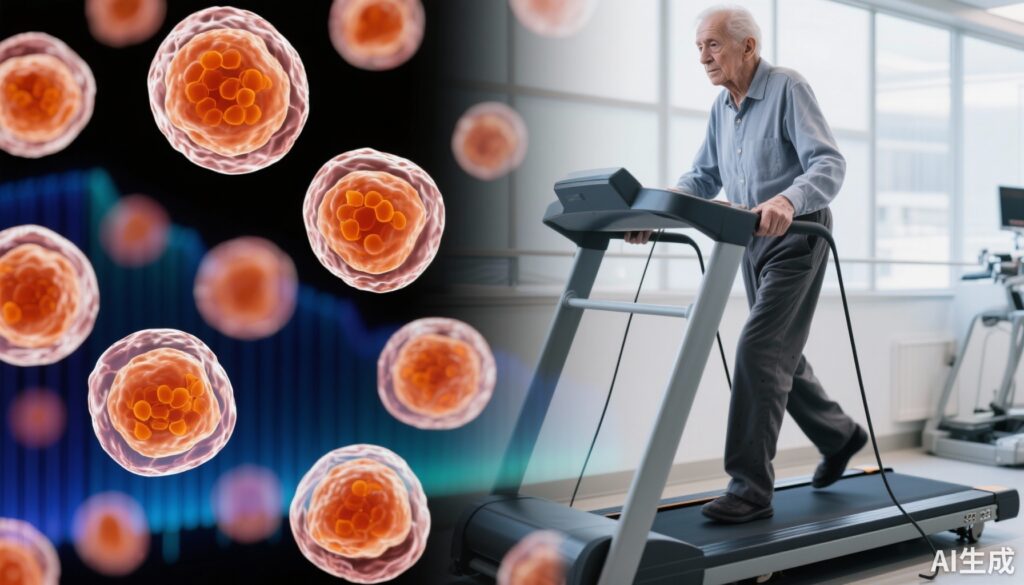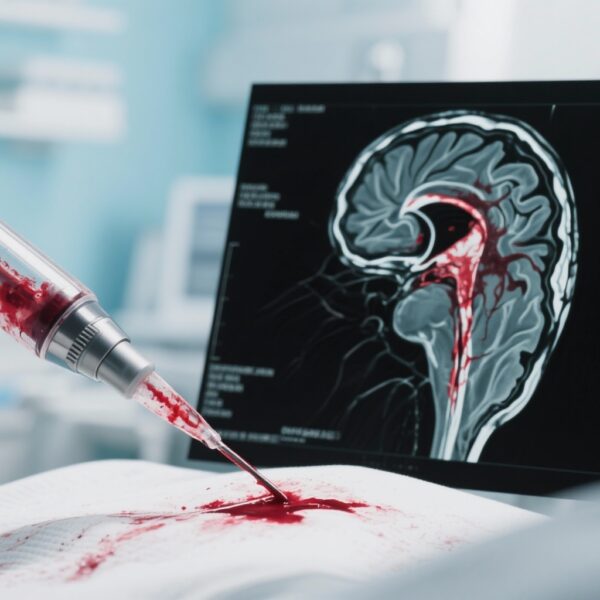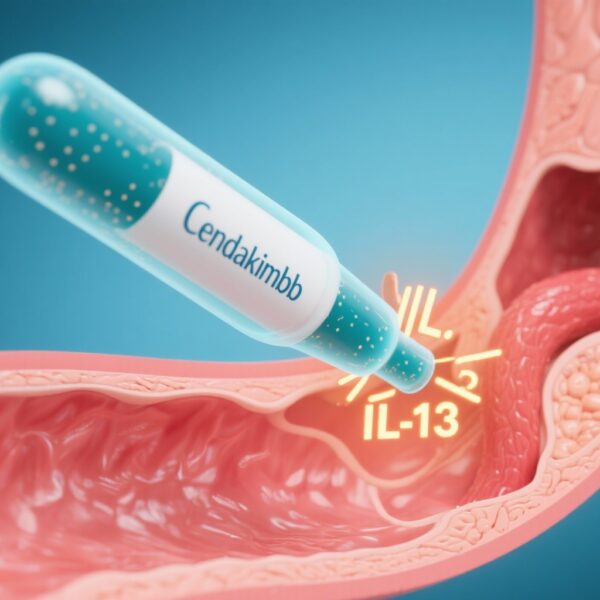Highlight
– Circulating extracellular vesicles (EV)-like particles carry biomolecules reflecting neurodegeneration and rehabilitation response in Parkinson’s disease (PD).
– Intensive treadmill rehabilitation induces molecular changes in EV-like particles, including increased carotenoid content.
– Improvements in gait speed and cadence reached clinically meaningful levels correlating with changes in circulating particle biochemistry.
– Raman spectroscopy of circulating particles’ carotenoid signature presents a novel biomarker for rehabilitation monitoring in PD.
Study Background and Disease Burden
Parkinson’s disease (PD) is a progressive neurodegenerative disorder characterized by motor symptoms such as bradykinesia, rigidity, and tremor, alongside non-motor manifestations. The pathology involves the accumulation and propagation of misfolded proteins and is marked by oxidative stress and inflammation. These pathological processes have been increasingly associated with extracellular vesicles (EVs) and other circulating nano-sized particles in the bloodstream, which mediate intercellular communication and trafficking of disease-related proteins. Antioxidants such as carotenoids, known to counteract oxidative damage, have not been extensively studied in relation to circulating EVs in PD.
Rehabilitation, particularly intensive motor training like treadmill walking, has demonstrated beneficial effects on motor performance in PD but lacks objective molecular biomarkers to monitor efficacy and predict recovery. The VIRTREAD-PD trial aimed to investigate the biochemical changes in circulating particles induced by intensive rehabilitation and their relation to clinical outcomes.
Study Design
This study enrolled 30 individuals diagnosed with idiopathic PD. Blood samples were collected at baseline (T0) and after an 8-week intensive treadmill-based rehabilitation program (T1). Circulating EV-like particles were isolated from serum using size exclusion chromatography, with additional verification for small EV markers (FLOT-1, TSG101, Alix, CD9) and lipoprotein presence (ApoA1). Nanoparticle tracking analysis (NTA) characterized particle concentration and size.
The biochemical composition of these particles was analyzed using Raman spectroscopy with particular attention to carotenoid peaks (1154 ± 10 cm−1 and 1514 ± 10 cm−1). Clinical and functional assessments included the Movement Disorder Society-Unified Parkinson’s Disease Rating Scale Part III (MDS-UPDRS III), Beck Depression Inventory (BDI), Modified Barthel Index (MBI), Montreal Cognitive Assessment (MoCA), and Performance Oriented Mobility Assessment (POMA) focusing on balance and gait components. Gait metrics such as cadence, speed, step length, and gait cycle times were quantitatively measured.
Non-parametric statistics (Wilcoxon signed-rank test for paired samples) were applied because data did not follow a normal distribution.
Key Findings
Clinically, motor scores (MDS-UPDRS III) and neuropsychological assessments (BDI, MoCA) remained statistically stable over the rehabilitation period, indicating no significant worsening or improvement in overall motor disability and cognition at group level. However, specific gait parameters showed significant improvement:
– Median self-selected cadence increased from 108 to 112 steps/min (p=0.007).
– Maximum cadence rose from 125 to 128 steps/min (p=0.029).
– Self-selected gait speed improved from 0.99 to 1.15 meters/second (p=0.03).
– Maximum gait speed increased from 1.34 to 1.50 meters/second (p=0.04).
– Self-selected gait cycle time decreased from 1.11 to 1.07 seconds (p=0.03).
– Maximum gait cycle time decreased from 0.97 to 0.93 seconds (p=0.05).
These gait improvements reached or approached minimally clinically important differences, indicating a tangible functional benefit from rehabilitation.
Biochemically, nanoparticle tracking analysis revealed a significant increase in circulating EV-like particle concentration post-rehabilitation (mean concentration rising from approximately 9.6×10^9 to 1.3×10^10 particles/mL, p<0.05), with no change in particle size distribution.
Raman spectroscopy documented distinct changes in the molecular signature of circulating particles after rehabilitation. Notably, peaks corresponding to carotenoids showed higher mean area under the curve (AUC) values at T1, reflecting increased carotenoid content associated with EV-like particles. The Amide I peak, indicative of protein secondary structure, remained stable as a reference.
Correlation analyses demonstrated that carotenoid spectral intensity positively correlated with patient age (Pearson coefficient 0.38; p=0.03) but showed no association with PD onset subtype, sex, or Hoehn and Yahr (HY) disease stage.
Taken together, the data indicate that rehabilitation modulates circulating EV-like particles' biochemical composition, increasing antioxidant molecule (carotenoid) association, which may relate to improved gait function.
Expert Commentary
The study by Gualerzi et al. provides novel insights into the dynamic biochemical milieu of circulating nanoparticles in PD and their modulation by exercise-based rehabilitation. Previous research has focused largely on EVs as carriers of pathological alpha-synuclein in PD progression, but this study uniquely highlights the potential reparative or protective molecular signatures, such as carotenoid content, associated with beneficial interventions.
Oxidative stress is a well-established contributor to PD pathogenesis, and carotenoids are potent antioxidants capable of mitigating oxidative damage. The observed increase in carotenoid signatures within circulating EV-like particles following motor rehabilitation suggests an adaptive systemic response that may support neuronal and muscular function.
The increase in EV particle concentration post-rehabilitation might reflect enhanced cellular communication or repair mechanisms. However, the study notes the technical challenges of EV isolation, including co-isolation of lipoproteins, which were accounted for by specific marker analyses.
Importantly, clinical measures such as MDS-UPDRS III and cognitive scores remained unchanged, emphasizing that gait parameters are more sensitive indicators of functional recovery in this context.
Limitations include the small sample size and lack of a randomized control group, which call for cautious interpretation and validation in larger cohorts. Additionally, the variability in carotenoid changes among subjects suggests individual differences in metabolic or oxidative status affecting response to rehabilitation.
Future work could explore mechanistic pathways linking circulating particles’ antioxidant cargo to neuroprotection and functional recovery, ideally integrating longitudinal assessments with multi-omics approaches.
Conclusion
The VIRTREAD-PD trial demonstrates that intensive treadmill rehabilitation in Parkinson’s disease induces significant functional gait improvements accompanied by biochemical modifications in circulating extracellular vesicle-like particles, notably increased carotenoid content. These findings advocate for a dual role of circulating particles both in PD neurodegeneration and rehabilitation response mechanisms.
Moreover, the Raman spectroscopic fingerprint of carotenoids linked to circulating nanoparticles emerges as a promising biomarker to objectively monitor rehabilitation efficacy and potentially predict recovery trajectories in PD.
Integrating molecular profiling of circulating particles into clinical practice could enhance personalized rehabilitation strategies and facilitate the development of adjunct antioxidant therapies, addressing an unmet need in comprehensive PD management.
References
1. Gualerzi A, Gerli M, Mangolini A, et al. Circulating particles carotenoids are associated with rehabilitation recovery in Parkinson’s disease. Redox Biol. 2025 Oct;86:103841. doi: 10.1016/j.redox.2025.103841. Epub 2025 Aug 22. PMID: 40865269; PMCID: PMC12409329.
2. Baudendistel K, et al. Minimal clinically important improvement of walking speed in Parkinson’s disease. Movement Disorders. 2012.
3. Théry C, et al. Minimal information for studies of extracellular vesicles 2018 (MISEV2018): a position statement of the International Society for Extracellular Vesicles. J Extracell Vesicles. 2018.
4. Hirsch EC, et al. Oxidative stress in Parkinson’s disease. Neurology. 1997.
5. Sharma M, et al. Role of carotenoids in neurodegenerative diseases. Neurochemistry International. 2020.




I got good info from your blog
Attractive component of content. I just stumbled upon your web site and in accession capital to say that I get in fact enjoyed account your weblog posts. Anyway I’ll be subscribing in your feeds or even I achievement you access consistently fast.